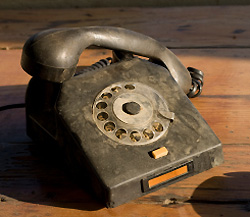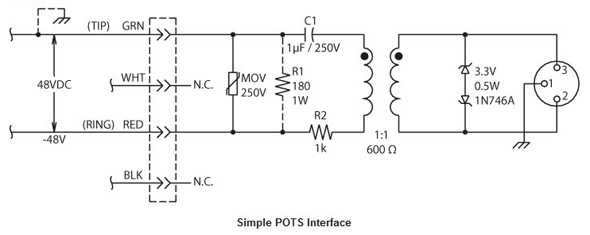In the USA, in spite of all the hoopla about digital-this, digital-that and fiber-optic-whatever, the truth is that many small commercial paging and music-on-hold applications still involve interfacing with the plain old telephone service, or “POTS”. (By contrast, if you work in the EU business place, then you will rarely run into POTS, since it has almost all been converted to ISDN.)
Meanwhile, back in the USA: if you are lucky, the telephone system you get to work with will provide a line-level auxiliary analog audio feed, but if not, then this article’s for you.
Analog Telephone Overview
An analog telephone line, at its simplest, is nothing more than a 600-ohm balanced line.
One pair of wires carries duplex (see Note 1 directly below) audio and 48 VDC for telephone operation. The 48 VDC is current limited by series resistors (one in each leg), therefore phones “on-hook” (no current drawn) typically measure 48 VDC, while phones “off-hook” (current drawn) typically measure 6 – 8 VDC.
(Note 1: Duplex means two-way; full duplex is redundant, but, alas, has been misused so long that it is here to stay; half duplex means one-way and is correct usage.)
Basically all phones work the same, yet many different systems coexist throughout the word. Major differences are found in wiring practices and connectors, line impedances, and loop currents, signaling tones and safety regulations. International harmonization is slowly changing this. The system described here is typical for the United States.
Long distance lines separate transmit and receive audio paths and use 4-wire cable (two pairs). Converting 2-wire local wiring to 4-wire long distance wiring requires a hybrid (see Note 2) and is not the subject of this note.
(Note 2: The name comes from the original use of a hybrid coil (special transformer) in the telephone whose function was to keep the send and receive signals separated.)
Teleconferencing applications require complex digital hybrids containing acoustic echo cancelling technology.
What is of concern here is how to add or remove audio from a normal telephone circuit without interfering with the operation of, or being harmed by, the telephone lines.
A phone patch, or phone tap, is necessary to interface line-level analog audio to and from POTS. The phone patch allows connecting standard audio equipment to a phone line, while isolating the audio equipment from ring tone and line voltage.
It operates in parallel with the telephone, with a circuit design that disturbs normal operation very little due to its high impedance input (if the hold resistor is not needed).
POTS Characteristics (typical)
Bandwidth: 300 – 3.3 kHz (3 kHz BW)
Signal-to-noise: 45 dB
Average Level: -9 dBm (275 mV) [0 dBm = 1 mW ( 0.775V) into 600 ohms]
Impedance: 600 ohms
Connector: RJ-11
Cable: 2-Wire (twisted pair)
DC Voltage: 48 V (±6 V typ) (see Note 3)
Polarity: Positive (tip or green wire) tied to earth ground so it measures 48 VDC (relative to ring or red wire) (see Note 4)
DC Current: 20-26 mA (typ)
DC Resistance: 200-300 ohms (typ)
AC Ring Volts & Freq.: 90 Vrms, 20 Hz (2 secs on, 4 secs off)
(Note 3: 48 VDC was selected because it qualifies as safe low voltage (
<50 VDC) in most countries and is easily created from four car batteries wired in series.
)
(Note 4: The positive terminal is earth grounded to minimize electrochemical reactions on wet telephone wiring. When the wires are at negative potential compared to the ground the metal ions flow from ground to the wire instead of the reverse situation where the metal from the wire migrates causing corrosion.)
Simple POTS Interface With Cautions
A single transformer and capacitor creates a POTS interface in a pinch; however adding a few more components greatly improves the performance. The transformer provides the necessary isolation, while the capacitor blocks the DC voltage from the transformer.
The diagram shows an enhanced version:
The MOV (metal-oxide varistor), or any similar transient voltage suppressor, is required due to the extreme lighting-induced voltage spikes that can travel on telephone lines (thousands of volts).
It needs a maximum operating voltage of at least 250 Vrms. This seems extreme for a 48 VDC powered line, but the telephone company tests their lines by adding as much as another 200 volts, so you must guard against the worst case.
It is not necessary to add a matching capacitor to the other leg of the transformer primary (to preserve the line balance) as will be seen shortly. Use a non-polar type since the polarity of the DC voltage cannot be guaranteed and oftentimes reverses with different operating modes. The value is not critical and depends on the reflected impedance seen by the series capacitor.
Normal usage for this type of phone patch is either to drive a high impedance (>10k ohms) input of a recorder or an amplifier, or, if used in the opposite direction (i.e., to add audio to the phone line), driven from a low impedance (
<300 ohms) output. The voltage rating must be high enough to withstand the usual DC voltage (and variations) plus the AC ring voltage; a value of 250 Vrms is recommended.
Since a 1μF/250V non-polar capacitor can be quite large (and expensive), consider paralleling two or more small non-polar caps (e.g., two 0.47μf/250V, or three 0.33μF/250V rated, etc.).
The resistor, R1, is necessary if the circuit must hold the line, i.e., look-like a phone off- hook. It must be selected to draw enough DC current to drop about 6 volts.
A big problem comes in predicting this value. The DC source is typically 48 volts, but can vary anywhere from 42-54 volts, and sometimes much more (24 60 volts).
Resistor R2 is a good idea to make the line driving impedance higher when using the patch to add audio (total equals R2 + line driver output impedance).

















